When to Harvest Potatoes UK: Complete Guide to Perfect Timing
Discover the perfect timing for harvesting potatoes in the UK. From first earlies in June to maincrops in autumn, learn the visual cues, proper techniques, and storage methods for maximum potato harvests.
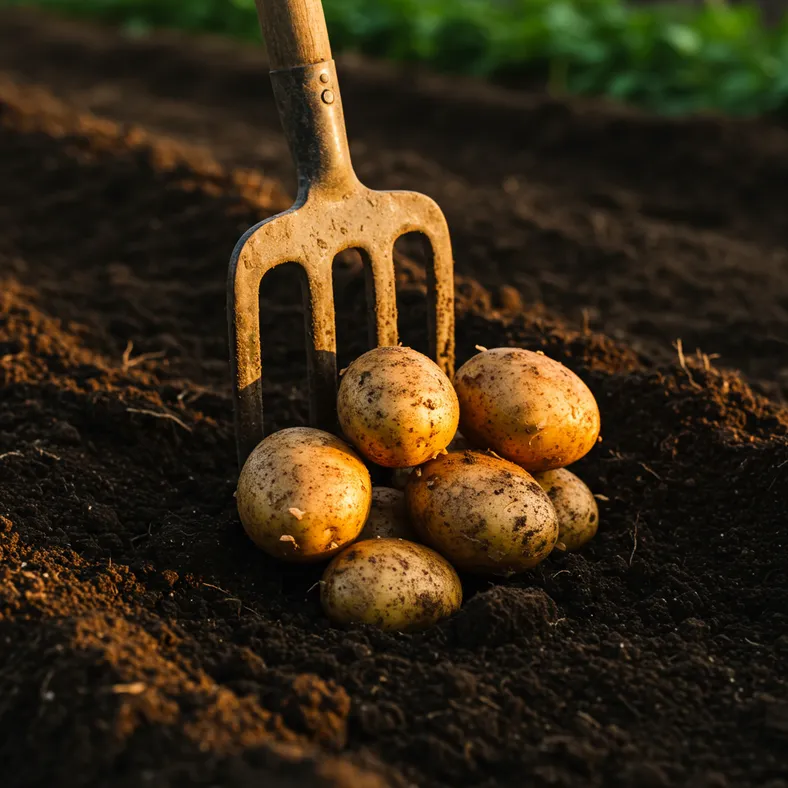
- Understanding Potato Types and Harvest Windows
- Visual Signs Your Potatoes Are Ready to Harvest
- Month-by-Month UK Harvest Calendar
- Proper Harvesting Techniques for Maximum Yield
- Post-Harvest Handling and Preparation
- Optimal Storage Methods for UK Conditions
- Common Harvesting Mistakes to Avoid
- Maximizing Your Potato Harvest Success
Harvesting potatoes is one of gardening's greatest pleasures – that moment when you carefully lift your plants to discover the treasure trove of tubers hidden beneath the soil. But knowing exactly when to harvest potatoes in the UK can be tricky, as the crop remains invisible underground until you're ready to dig.
Whether you're growing first earlies for those delicious June new potatoes or maincrops for winter storage, timing your harvest correctly ensures the best flavour, texture, and storage life. Get it wrong, and you might end up with small, underdeveloped tubers or potatoes that don't store well through winter.
This comprehensive guide will teach you the visual cues, timing windows, and proven techniques UK gardeners use to harvest perfect potatoes every time.
Understanding Potato Types and Harvest Windows
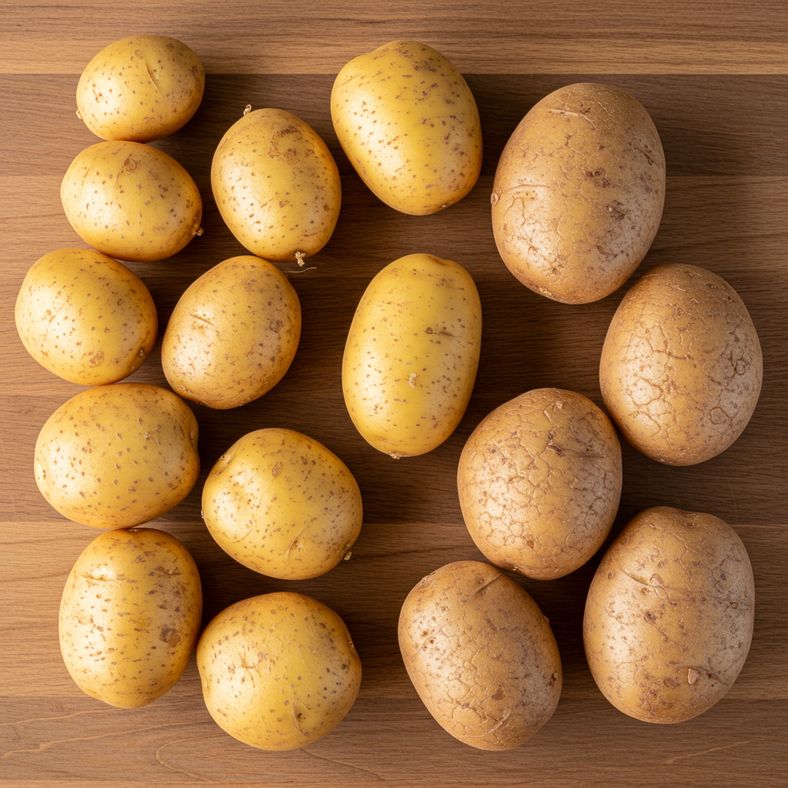
Before you can master potato harvesting, you need to understand the three main categories of potatoes and their different maturation schedules in the UK climate.
First Early Potatoes (New Potatoes)
First earlies are your summer treats – small, tender new potatoes with delicate skins that practically slip off when cooked. These varieties mature fastest, typically ready for harvest in June to early July, approximately 10-12 weeks after planting.
Popular first early varieties include 'Maris Bard', 'Rocket', and 'Swift'. These potatoes are best harvested when they're about the size of a hen's egg and consumed fresh rather than stored.
Second Early Potatoes
Second earlies bridge the gap between new potatoes and storage crops, maturing in July to August, roughly 13-16 weeks after planting. They're slightly larger than first earlies and can be used fresh or stored for a few weeks.
Excellent second early varieties include 'Charlotte', 'Jazzy', and 'Kestrel'. These offer more substantial harvests than first earlies while maintaining good eating quality.
Maincrop Potatoes
Maincrops are your winter staples – larger potatoes perfect for roasting, baking, and long-term storage. They mature from late August through October, taking 18-22 weeks from planting to harvest.
Popular maincrop varieties include 'Maris Piper', 'King Edward', and 'Desiree'. These potatoes can be stored for several months when harvested and handled correctly.
Visual Signs Your Potatoes Are Ready to Harvest
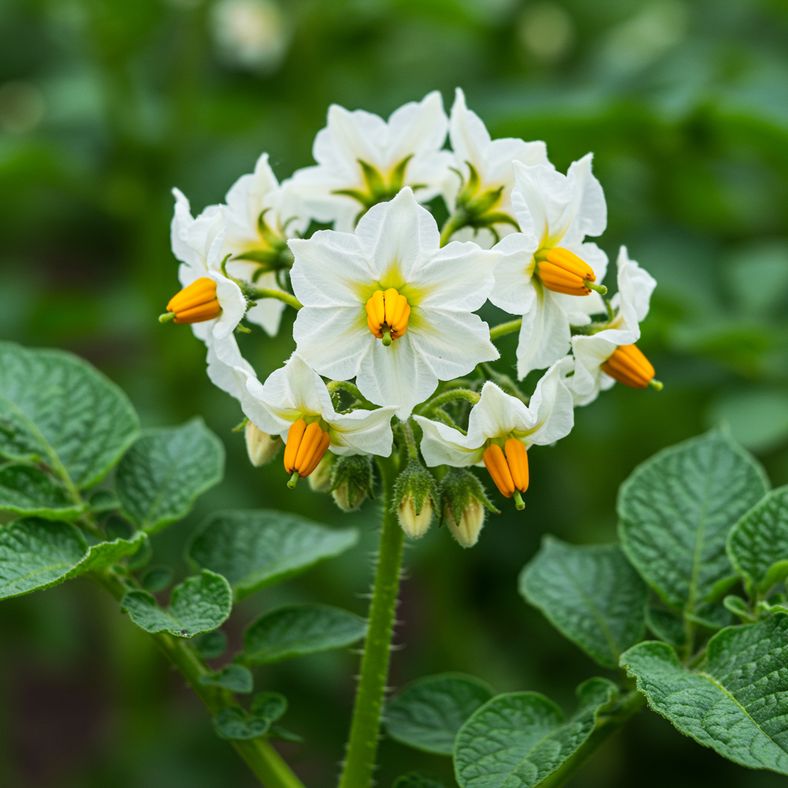
Since potatoes grow underground, you need to rely on above-ground visual cues to determine harvest readiness. Learning to read these signs is crucial for timing your harvest perfectly.
Flowering Signals for Early Varieties
For first and second early potatoes, flowering is your primary harvest indicator. Once the plants begin flowering or the flower buds start to drop, your new potatoes are typically ready for harvesting. The flowers usually appear white, pink, or purple depending on the variety.
If your potato plants don't flower (some varieties are poor flowerers), count the weeks from planting and use the timing guides above as your backup method.
Foliage Changes for Maincrop Varieties
Maincrop potatoes require different visual cues. Watch for these signs:
- Yellowing leaves – The lower leaves begin turning yellow and dying back
- Stem browning – Stems start to turn brown and become less vigorous
- Natural die-back – The entire plant begins its natural senescence process
For immediate use, you can harvest maincrops when the plant is still healthy but flowers have finished. For storage, wait until the foliage has died back naturally.
The Test Dig Method
When in doubt, perform a careful test dig. Using a hand trowel, gently excavate around one plant about 30cm away from the stem. Check the size and skin condition of the tubers:
- Ready potatoes have firm, well-developed skins that don't rub off easily
- Unready potatoes have thin, papery skins that scrape off with your thumbnail
- Size matters – earlies should be at least hen's egg size for best flavour
Month-by-Month UK Harvest Calendar
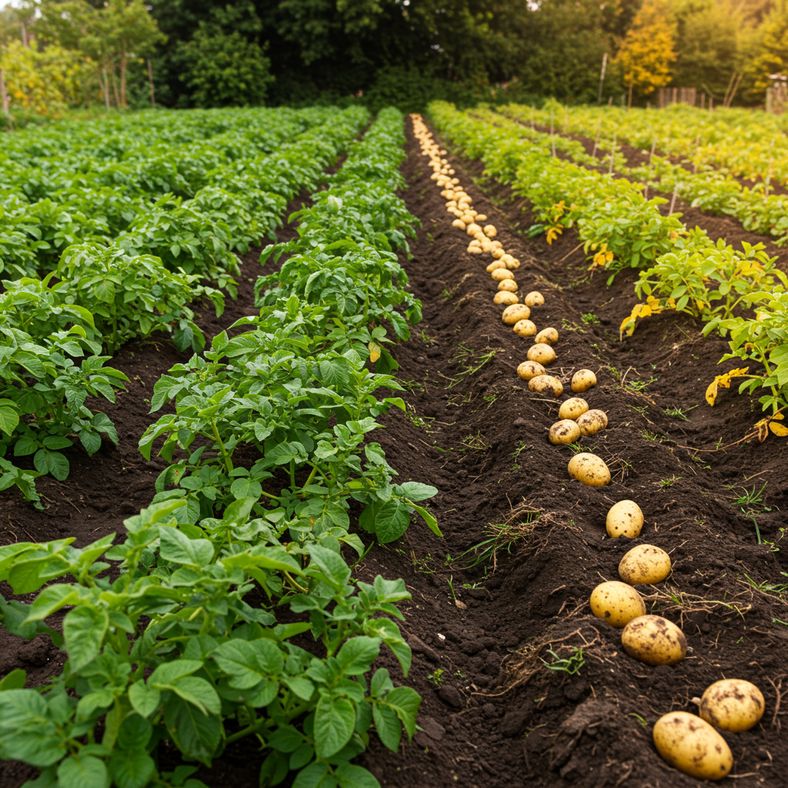
UK growing conditions vary significantly from Scotland to Cornwall, so use this calendar as a guide and adjust based on your local climate and actual planting dates.
June Harvesting
What to harvest: First early varieties planted in March
Typical varieties: 'Maris Bard', 'Rocket', 'Arran Pilot'
Signs to look for: Plants flowering or flower buds dropping
Harvest notes: These are true new potatoes with tender skins. Handle gently and use within a few days for best flavour.
July Harvesting
What to harvest: Later first earlies and early second earlies
Typical varieties: 'Swift', 'Epicure', early 'Charlotte'
Signs to look for: Full flowering finished, some foliage may start yellowing
Harvest notes: Peak new potato season. Perfect for salads and light summer meals.
August Harvesting
What to harvest: Second early varieties and early maincrops
Typical varieties: 'Jazzy', 'Kestrel', early 'Maris Piper'
Signs to look for: Foliage beginning to yellow and die back
Harvest notes: These potatoes can be used fresh or stored for a few weeks.
September Harvesting
What to harvest: Main season maincrop varieties
Typical varieties: 'King Edward', 'Desiree', 'Cara'
Signs to look for: Significant foliage die-back, stems turning brown
Harvest notes: Perfect timing for potatoes intended for autumn use.
October Harvesting
What to harvest: Late maincrop varieties for winter storage
Typical varieties: 'Maris Piper', 'Rooster', 'Sante'
Signs to look for: Complete foliage die-back, dry stems
Harvest notes: Latest safe harvest before frost risk. Essential for long-term storage potatoes.
Important: Always complete your harvest before the first hard frost, typically by mid to late October in most UK regions.
Proper Harvesting Techniques for Maximum Yield
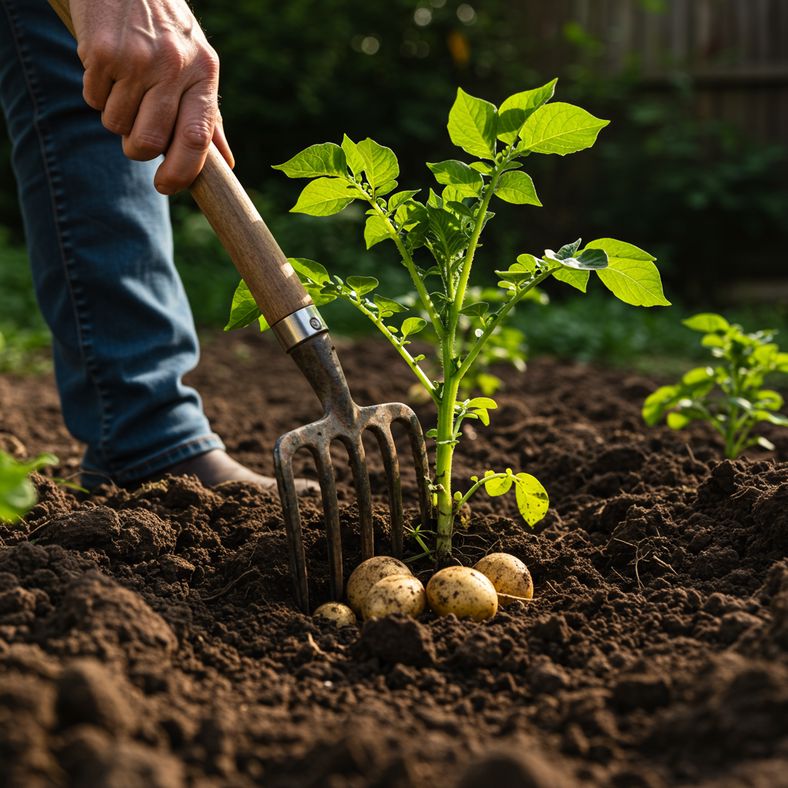
How you harvest your potatoes is just as important as when you harvest them. Proper technique prevents damage and ensures your potatoes store well.
Essential Harvesting Tools
Before you begin, gather the right tools for the job:
- Garden fork – Preferred over spades as it's less likely to pierce tubers
- Hand trowel – For careful excavation and test digs
- Garden kneeler – Makes hand-picking more comfortable
- Collection containers – Avoid metal buckets that can bruise potatoes
For quality gardening tools that make harvesting easier, consider investing in professional-grade JiveSnip Premium Titanium Garden Secateurs for cutting back foliage before harvest.
Step-by-Step Harvesting Process
1. Choose the right weather
Harvest on a dry day when the soil isn't waterlogged. Wet conditions make harvesting messy and can increase storage problems.
2. Prepare the plants
For maincrop potatoes intended for storage, cut back the foliage to ground level 7-10 days before harvesting. This allows the skins to set properly.
3. Begin excavation
Insert your garden fork at least 30cm (12 inches) away from the base of the plant to avoid spearing tubers. Work systematically along the row.
4. Lift carefully
Gently lever the fork to lift the root ball. Most potatoes will come up with the plant, but many remain in the soil.
5. Hand-pick remaining tubers
Carefully search through the loosened soil by hand. Potatoes can be found surprisingly far from the original plant position.
6. Sort immediately
Separate damaged potatoes for immediate use and perfect ones for storage. Discard any green or diseased tubers.
Container Growing Harvest Method
If you're growing potatoes in containers, harvesting becomes much easier:
- Simply tip out the entire contents onto a tarp or into a wheelbarrow
- Pick through the compost by hand to collect all tubers
- This method virtually eliminates accidental damage from tools
- The compost can be reused for other plants after removing potato roots
Post-Harvest Handling and Preparation

What you do immediately after harvesting significantly impacts your potatoes' storage life and eating quality. Proper post-harvest handling is crucial for success.
Immediate Post-Harvest Steps
Gentle cleaning
Remove excess soil by gently brushing with your hands or a soft brush. Avoid washing potatoes intended for storage, as moisture encourages rot. Only wash potatoes you plan to use within a few days.
Damage assessment
Sort potatoes into three categories:
- Perfect condition – No cuts, bruises, or blemishes (ideal for long-term storage)
- Minor damage – Small cuts or bruises (use within 1-2 weeks)
- Major damage – Deep cuts or extensive bruising (use immediately)
Green potato disposal
Discard any potatoes with green patches, as these contain solanine, a toxic compound. Green potatoes are not safe to eat, even with the green parts removed.
Skin Setting for Storage Potatoes
Maincrop potatoes intended for storage need their skins to 'set' properly:
- After harvesting, lay potatoes on newspaper or wooden trays
- Leave in a well-ventilated, dark place for 7-10 days
- Ideal temperature is 10-15°C with good air circulation
- This process toughens the skin and reduces storage losses
Curing Process
Professional growers cure their potatoes before storage. You can adapt this process for home use:
- Spread potatoes in a single layer on slatted trays or newspaper
- Keep in darkness at 12-15°C for 10-14 days
- Ensure good ventilation to prevent condensation
- Turn potatoes once during the curing period
This curing process heals minor wounds and prepares the potatoes for long-term storage.
Optimal Storage Methods for UK Conditions
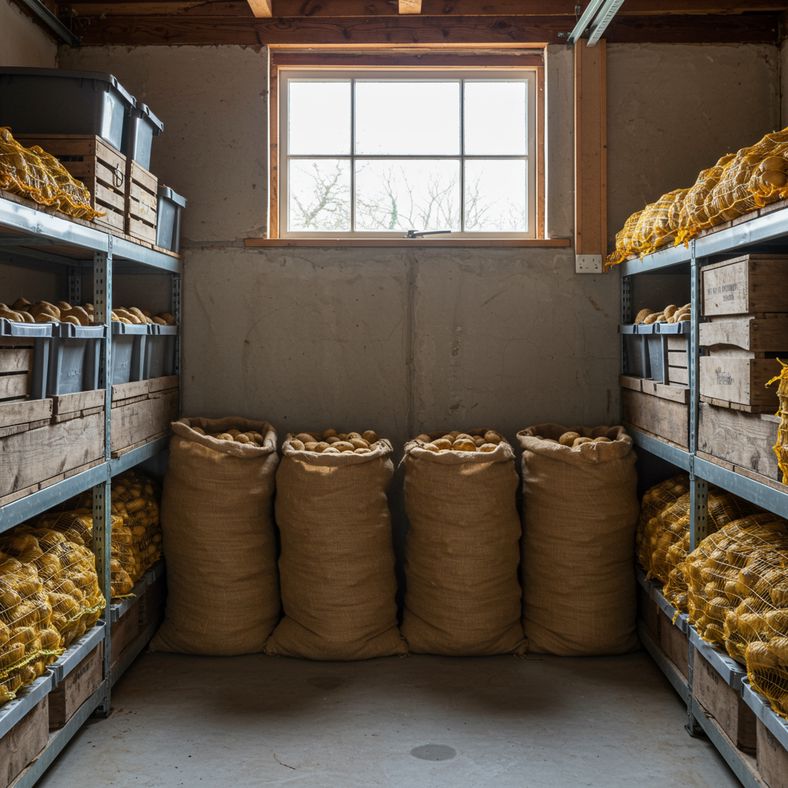
Proper storage can keep your maincrop potatoes fresh and edible through winter and into early spring. UK's variable climate requires specific storage considerations.
Ideal Storage Conditions
Temperature: 4-7°C (39-45°F)
Humidity: 85-90% relative humidity
Ventilation: Good air circulation without drafts
Darkness: Complete darkness to prevent greening
Duration: 4-6 months for most varieties
Storage Container Options
Hessian sacks
Traditional and effective, allowing air circulation while blocking light. Hang from hooks or store on slatted shelves.
Paper sacks
Good for smaller quantities. Fold the top down to exclude light and store in a cool place.
Wooden crates
Excellent for larger harvests. Line with newspaper and store in layers no more than 30cm deep.
Avoid plastic bags
Never store potatoes in plastic bags, as this traps moisture and causes rapid deterioration.
Storage Location Ideas
Garage or shed
Ideal if temperatures remain stable and don't freeze. Insulate if necessary.
Cellar or basement
Perfect natural conditions if available. Monitor for excess moisture.
Spare bedroom
Works if you can maintain cool temperatures and complete darkness.
Purpose-built storage
Consider building an insulated potato clamp in the garden for larger harvests.
Storage Monitoring and Maintenance
Check stored potatoes every 2-3 weeks:
- Remove any sprouting, soft, or diseased tubers immediately
- One bad potato can quickly spread problems to others
- Maintain consistent temperature and humidity
- Ensure continued darkness to prevent greening
Signs of storage problems:
- Sprouting (too warm or exposed to light)
- Soft patches (too warm or too humid)
- Green patches (light exposure)
- Sweet taste (too cold – starch converting to sugar)
Common Harvesting Mistakes to Avoid

Learning from common mistakes can save you from disappointing harvests and storage failures. Here are the most frequent errors UK gardeners make when harvesting potatoes.
Timing Errors
Harvesting too early
Impatience often leads to harvesting undersize potatoes with poor flavour. Small tubers also don't store well and offer poor value for your growing effort.
Harvesting too late
Leaving potatoes in the ground too long risks:
- Slug and pest damage
- Disease problems in wet autumns
- Frost damage if left past October
- Oversized potatoes with poor texture
Ignoring weather conditions
Harvesting in wet conditions creates muddy, difficult-to-clean potatoes and increases storage problems.
Handling Mistakes
Using inappropriate tools
Spades and shovels commonly damage tubers. Sharp edges can slice through potatoes, creating wounds that lead to storage rot.
Rough handling
Dropping potatoes into hard containers or throwing them can cause internal bruising that isn't immediately visible but affects storage life.
Inadequate soil search
Many gardeners miss up to 30% of their crop by not thoroughly searching the soil. Potatoes can travel surprisingly far from the original plant.
Storage Preparation Errors
Washing before storage
Washing adds moisture that encourages rot. Only wash potatoes you plan to use immediately.
Storing damaged potatoes
Even small cuts can lead to storage problems. Always sort carefully and use damaged potatoes first.
Mixed variety storage
Different varieties have different storage lives. Store varieties separately to manage them effectively.
Environmental Mistakes
Inadequate curing
Rushing potatoes into storage without proper curing reduces storage life significantly.
Poor storage conditions
Too warm, too cold, too humid, or light exposure all cause rapid deterioration.
Insufficient monitoring
Stored potatoes need regular checking. Problems spread quickly if not caught early.
Maximizing Your Potato Harvest Success
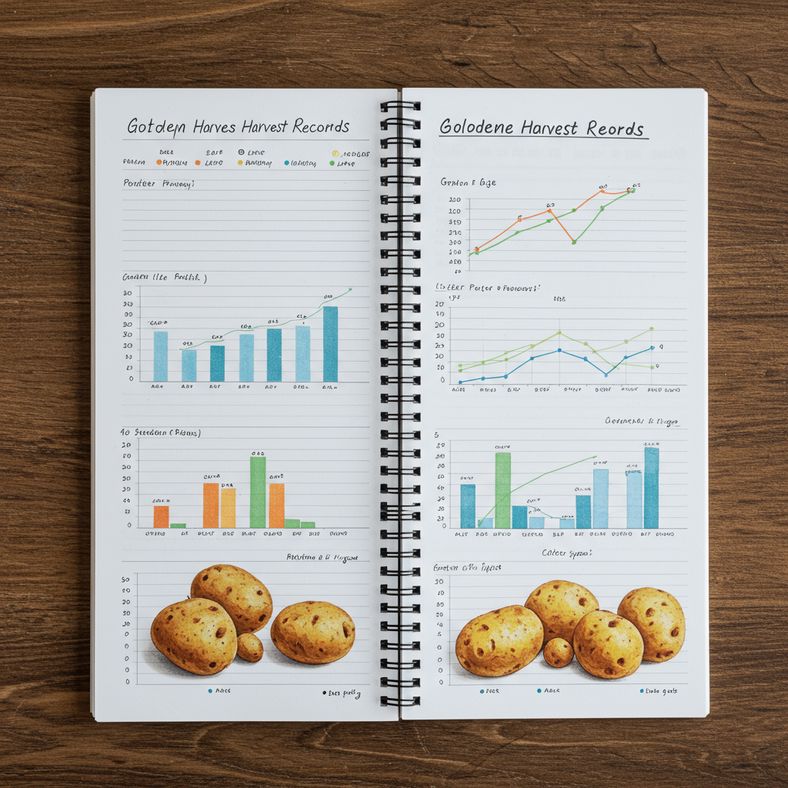
Beyond basic harvesting, these advanced tips help UK gardeners achieve consistently excellent potato crops year after year.
Succession Planting for Extended Harvests
Plan multiple plantings to extend your harvest season:
- Plant first earlies in late March, early April, and mid-April
- Plant second earlies in early April and late April
- Plant maincrops from mid-April through early May
This approach provides fresh potatoes from June through October and reduces storage pressure.
Variety Selection for UK Conditions
Choose varieties suited to your local climate and storage facilities:
For wet areas: Disease-resistant varieties like 'Sarpo Mira' or 'Carolus'
For dry areas: Drought-tolerant varieties like 'Maris Bard' or 'Charlotte'
For long storage: Traditional maincrops like 'Maris Piper' or 'King Edward'
For containers: Compact varieties like 'Rocket' or 'Swift'
Record Keeping for Improvement
Maintain a potato harvest diary recording:
- Planting dates and varieties
- Weather conditions during growing season
- Harvest dates and yields
- Storage success rates
- Pest and disease observations
This information becomes invaluable for improving future crops.
Soil Health Considerations
Potato harvesting affects soil structure. After harvest:
- Add compost or well-rotted manure to replace nutrients
- Consider cover crops if the bed won't be replanted immediately
- Practice crop rotation to prevent disease buildup
- Test soil pH and adjust if necessary
Planning Next Year's Crop
Use harvest time to plan improvements:
- Order seed potatoes early for best variety selection
- Consider new varieties based on this year's performance
- Plan crop rotation schedule
- Assess and improve storage facilities
For planning next year's garden, consider starting other crops from seed. High-quality Little Gem Lettuce Seeds can provide fresh salads to accompany your new potatoes.
Disclaimer: This article contains Amazon affiliate links. We may earn a small commission from qualifying purchases at no additional cost to you.